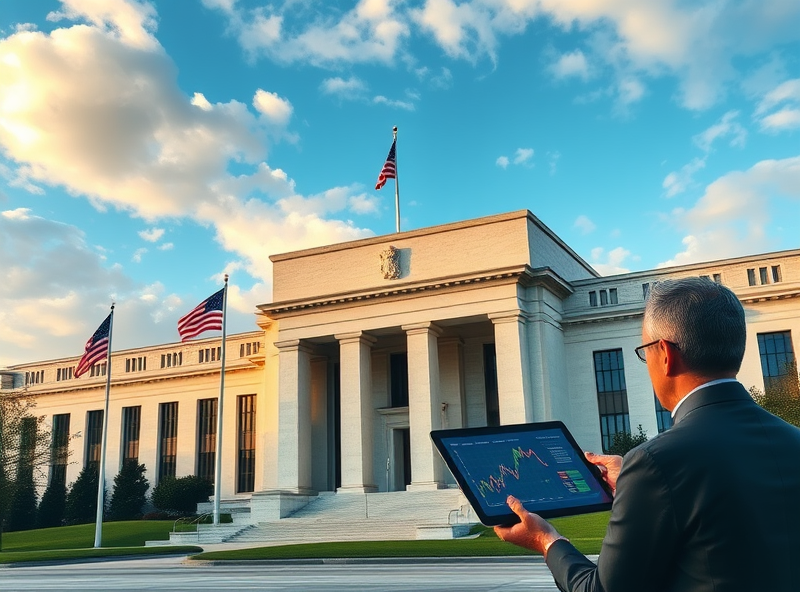
Global Central Bank Trends in 2024-2025: A Cautious Turn

Ever wonder why your mortgage rate suddenly changes or why your overseas vacation got more expensive? The answer often lies in the decisions made by central banks around the world. In 2025, we’re witnessing a fascinating period where different countries are taking dramatically different approaches to monetary policy – and these decisions are directly impacting your wallet, your investments, and your financial future.
Let’s break down what’s happening globally and, more importantly, what it means for you as an American investor, homeowner, or business owner.
The Fed’s Steady Hand: Why America Is Playing It Safe
The Current US Strategy: Patience Over Panic
The Federal Reserve has adopted what many economists call a “wait and see” approach in 2025. After the aggressive rate hikes of 2022-2023 that brought inflation down from its painful peaks, the Fed is now holding interest rates steady, typically in the 5.0-5.5% range for the federal funds rate.
Why is the Fed being so cautious? Several key factors are driving this decision:
Inflation Progress (But Not Victory) While inflation has cooled significantly from its 2022 highs of over 9%, it’s still hovering around 3-4% – above the Fed’s 2% target. Fed Chair Jerome Powell has made it clear that they want to see sustained progress toward 2% before considering rate cuts.
Labor Market Strength The US job market remains remarkably resilient. With unemployment still near historic lows and wage growth continuing, the Fed doesn’t feel pressure to stimulate the economy through lower rates.
Global Trade Uncertainties Ongoing tensions with China and shifting trade relationships with Europe continue to create economic uncertainty. The Fed is maintaining flexibility to respond to potential disruptions.
What This Means for Your Daily Life
Mortgage Rates: Stability with a Side of Opportunity
- Current 30-year fixed mortgage rates are hovering around 6.5-7.5%
- While higher than the historic lows of 2020-2021, they’re providing stability for planning
- Smart move: If you’re house hunting, consider locking in rates now rather than waiting for cuts that may not come soon
Credit Cards and Personal Loans
- Credit card rates remain elevated (often 20%+ APR)
- Personal loan rates are similarly high
- Action item: Now is an excellent time to pay down high-interest debt
Savings Accounts and CDs
- High-yield savings accounts are paying 4-5% APY
- CDs are offering attractive rates for those willing to lock in funds
- Opportunity: Take advantage of these higher rates while they last
Business Implications
- Small business loan rates remain elevated but stable
- Companies are focusing on efficiency over expansion
- Strategic thinking: Businesses should prioritize cash flow management and operational improvements
Investment Implications of Fed Policy
Bond Market Dynamics The Fed’s steady approach has created interesting opportunities in the bond market:
- Short-term bonds (1-3 years) are offering attractive yields with lower duration risk
- Long-term bonds could benefit if the Fed eventually cuts rates
- TIPS (Treasury Inflation-Protected Securities) remain valuable for inflation protection
Stock Market Considerations
- Dividend-paying stocks become more attractive in a higher-rate environment
- Growth stocks face continued pressure from elevated rates
- Financial sector stocks (banks, insurance) benefit from higher net interest margins
Europe’s Delicate Balance: ECB and BOE Navigate Choppy Waters
The European Central Bank’s Calculated Pivot
After one of the most aggressive tightening cycles in ECB history, Christine Lagarde and her team are now carefully considering their next moves. The ECB has raised rates from negative territory to around 4.5%, and now they’re in a delicate balancing act.
Key Challenges Facing Europe:
- Persistent but declining inflation still above the 2% target
- Weak economic growth across major eurozone economies
- Energy price volatility due to geopolitical tensions
- Divergent economic performance between northern and southern European countries
What’s Different About Europe’s Approach: Unlike the Fed’s broad-based strategy, the ECB must consider the needs of 19 different countries with varying economic conditions. Germany might need different medicine than Italy or Spain.
Bank of England: Brexit Aftermath and Inflation Battles
The UK faces unique challenges post-Brexit, and the Bank of England is walking an even tighter tightrope:
Specific UK Challenges:
- Labor shortages due to Brexit-related immigration changes
- Supply chain disruptions affecting inflation differently than other countries
- Housing market concerns with elevated prices and affordability issues
- Pound sterling volatility affecting import costs
How European Policy Affects American Investors
Currency Implications
- A potentially weaker Euro and Pound could benefit US exporters
- American tourists to Europe might find better exchange rates
- US companies with European operations face translation risks
Investment Opportunities
- European stocks might become more attractive if rate cuts stimulate growth
- Currency-hedged European ETFs could provide exposure without FX risk
- Multinational companies with European exposure could see earnings impacts
Asia’s Monetary Policy Mosaic: Three Different Approaches
Japan: The Outlier’s Persistence
Japan continues to march to the beat of its own drum, maintaining ultra-loose monetary policy even as the rest of the world tightens or holds steady.
Why Japan Is Different:
- Decades of deflation have created different economic dynamics
- Aging population puts downward pressure on growth and inflation
- Massive government debt requires careful coordination between fiscal and monetary policy
- Export-dependent economy benefits from a weaker yen
Bank of Japan’s Unique Tools:
- Negative interest rates (currently -0.1%)
- Yield curve control targeting 10-year government bond yields
- Massive bond purchasing programs
- Forward guidance promising continued accommodation
Impact on Global Markets:
- Japanese investors seeking higher yields abroad (the “carry trade”)
- Weaker yen supporting Japanese exporters but hurting importers
- Global bond markets influenced by BOJ’s massive buying
China: Targeted Stimulus in a Slowing Economy
China’s monetary policy approach is perhaps the most complex, given the country’s unique economic structure and current challenges.
China’s Current Economic Headwinds:
- Property sector crisis with major developers in distress
- Weak consumer confidence affecting domestic demand
- Youth unemployment reaching concerning levels
- Geopolitical tensions affecting trade and investment
People’s Bank of China’s Response:
- Selective rate cuts rather than broad-based easing
- Targeted lending programs for specific sectors
- Reserve requirement ratio cuts to increase bank lending capacity
- Currency stability measures to prevent capital flight
What This Means Globally:
- Reduced Chinese demand affecting commodity prices
- Potential for increased Chinese exports as domestic demand weakens
- Currency pressures affecting emerging markets
South Korea: The Balanced Approach
South Korea represents a middle path between the aggressive policies of other countries.
Korea’s Balanced Challenges:
- Household debt concerns limiting policy flexibility
- Export dependence on China and the US creating external vulnerabilities
- Inflation pressures requiring continued vigilance
- Housing market overheating in major cities
Bank of Korea’s Strategy:
- Gradual policy adjustments rather than dramatic moves
- Financial stability considerations weighing heavily on decisions
- Data-dependent approach similar to the Fed
The Global Picture: Currency Wars and Investment Implications
Understanding Exchange Rate Pressures
The divergent monetary policies we’re seeing globally are creating significant currency pressures that affect everyone – from individual investors to multinational corporations.
The Strong Dollar Phenomenon With the Fed holding rates steady at relatively high levels while other countries cut or consider cuts, the US dollar has remained strong. This creates several effects:
Benefits for Americans:
- Cheaper imports – everything from electronics to clothing costs less
- Better travel deals – your dollars go further overseas
- Lower inflation – stronger dollar helps keep import prices down
Challenges for Americans:
- US exporters struggle – American goods become more expensive abroad
- Multinational company earnings get hurt by currency translation
- Emerging market investments face headwinds from dollar strength
Smart Investment Strategies in This Environment
Diversification Is Key In a world of divergent monetary policies, diversification becomes even more critical:
Geographic Diversification:
- US-focused investments for stability and dollar strength benefits
- International exposure for potential opportunities as other countries ease policy
- Emerging markets selectively, focusing on countries with sound fundamentals
Sector Considerations:
- Financial stocks benefit from higher rates (US banks, insurance companies)
- Consumer staples provide stability during uncertain times
- Technology faces headwinds from higher rates but offers long-term growth
- Energy and commodities affected by global economic growth and currency movements
Fixed Income Strategy:
- Short-term US bonds for safety and attractive yields
- International bonds for diversification (consider currency hedging)
- Inflation-protected securities as insurance against policy missteps
Practical Steps for Individual Investors
1. Review Your Asset Allocation
- Ensure your portfolio reflects current global realities
- Consider increasing US dollar exposure if you’re heavily international
- Rebalance regularly as market dynamics shift
2. Manage Currency Risk
- If you have significant international investments, consider hedged funds
- For unhedged investments, think of currency movements as part of your risk/return profile
- Don’t try to time currency movements – focus on long-term trends
3. Take Advantage of Higher Rates
- Lock in attractive CD rates while they’re available
- Consider I-bonds for inflation protection
- High-yield savings accounts are actually high-yield right now
4. Debt Management
- Pay down variable-rate debt while rates are high
- Consider refinancing fixed-rate debt if you have good credit
- Avoid taking on unnecessary debt in a high-rate environment
What to Watch: Key Indicators and Timing
Economic Data That Matters
US Indicators to Monitor:
- Monthly inflation data (CPI) – the Fed’s primary focus
- Employment reports – job market strength affects Fed decisions
- GDP growth – economic resilience influences policy timing
- Consumer spending – the engine of the US economy
Global Indicators:
- European PMI data – manufacturing and services activity
- Chinese economic data – property sales, retail sales, industrial production
- Currency movements – dollar strength/weakness affects everyone
Central Bank Communication
Fed Speak Translation:
- “Data dependent” = We’re not committing to anything yet
- “Gradual approach” = Changes will be slow and well-telegraphed
- “Appropriate policy stance” = We think we’re in the right place for now
Reading Between the Lines: Central bankers are careful with their words, but their speeches and meeting minutes provide valuable clues about future policy direction.
Looking Ahead: Scenarios for 2025 and Beyond
Scenario 1: Soft Landing Success
What it looks like: Inflation continues declining without triggering recession Policy response: Gradual Fed rate cuts starting late 2025 Investment implications: Broad market rally, rotation to growth stocks
Scenario 2: Persistent Inflation
What it looks like: Inflation stalls above 3% despite current policies Policy response: Fed holds rates higher for longer, possibly raises again Investment implications: Continued pressure on bonds and growth stocks, strength in value and dividend stocks
Scenario 3: Global Economic Slowdown
What it looks like: Trade tensions and policy divergence trigger broader weakness Policy response: Coordinated central bank easing Investment implications: Flight to quality, US dollar strength, defensive positioning
Scenario 4: Geopolitical Shock
What it looks like: Major geopolitical event disrupts global trade and markets Policy response: Emergency policy coordination, potential fiscal stimulus Investment implications: High volatility, focus on essential sectors and safe havens
Your Action Plan: Preparing for Multiple Scenarios
Immediate Steps (Next 3 Months)
- Review and rebalance your investment portfolio
- Lock in high-yield savings rates for emergency funds
- Pay down high-interest debt while you can
- Consider currency exposure in your international investments
Medium-term Strategy (3-12 Months)
- Dollar-cost average into quality investments
- Build cash reserves for opportunities
- Monitor Fed communications for policy shift signals
- Diversify geographically but maintain US focus
Long-term Positioning (1-3 Years)
- Maintain disciplined approach regardless of policy changes
- Focus on quality companies with strong balance sheets
- Consider inflation hedges for portfolio protection
- Stay globally diversified but understand currency risks
Key Resources for Staying Informed
Official Sources
- Federal Reserve (federalreserve.gov) – Policy statements, meeting minutes, economic data
- European Central Bank (ecb.europa.eu) – ECB policy decisions and economic analysis
- Bank of England (bankofengland.co.uk) – UK monetary policy and financial stability
- International Monetary Fund (imf.org) – Global economic outlook and analysis
Market Analysis
- Federal Reserve Economic Data (FRED) – Comprehensive economic statistics
- Bureau of Labor Statistics – US employment and inflation data
- Your brokerage research – Most major brokers provide excellent global economic analysis
Educational Resources
- Investopedia – Clear explanations of monetary policy concepts
- Council on Foreign Relations – Geopolitical analysis affecting markets
- Peterson Institute for International Economics – Policy analysis and research
The Bottom Line: Staying Ahead in a Complex World
The global monetary policy landscape in 2025 is more complex than we’ve seen in decades. Different countries are taking different approaches based on their unique economic challenges, and these decisions are creating both opportunities and risks for American investors.
The key takeaways for your financial success:
- Stay informed but don’t overreact – Policy changes happen slowly, giving you time to adjust
- Diversify thoughtfully – Geographic and sector diversification remain crucial
- Take advantage of current opportunities – High savings rates and stable policy create planning windows
- Prepare for multiple scenarios – Flexibility in your approach beats trying to predict the future
- Focus on fundamentals – Quality investments and sound financial planning work in any policy environment
Remember, while central bank policies create the backdrop for financial markets, your personal financial success depends more on consistent saving, smart investing, and staying disciplined through market cycles. Use this knowledge to make informed decisions, but don’t let policy uncertainty paralyze your financial progress.
The global economy is complex, but your approach to building wealth doesn’t have to be. Stay informed, stay diversified, and stay focused on your long-term goals. Your future self will thank you for the smart decisions you make today, regardless of what central banks do tomorrow.
Disclaimer: This article is for educational purposes only and should not be considered personalized financial or investment advice. Monetary policy can change rapidly, and past performance does not guarantee future results. Always consult with qualified financial advisors and conduct your own research before making investment decisions.







